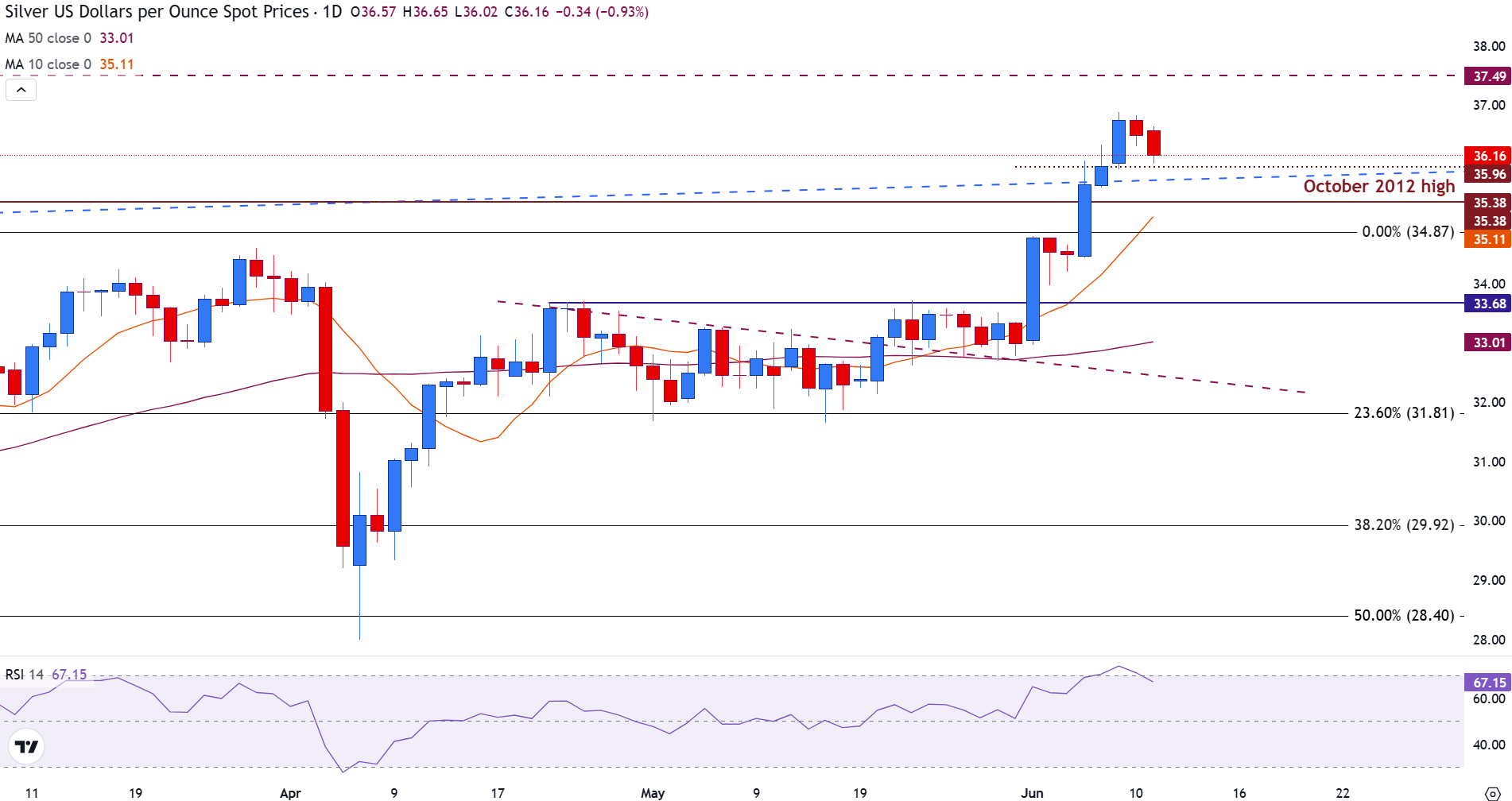Silver slips as price retreats from overbought territory on easing US-China trade talks
- Silver prices extend losses as bullish momentum remains in overbought terrain.
- US President confirms positive progress with China, which lifted Silver to multi-decade highs.
- XAG/USD price action remains above $36.00 with the Relative Strength Index (RSI) at 67.
Silver prices are easing on Wednesday, retreating from multi-year highs as bullish momentum fades and traders lock in profits.
The metal is currently hovering near the $36.00 psychological support zone, having tested its highest levels since February 2012 earlier this week.
On Tuesday, high-level negotiations between the US and China concluded in London with a provisional framework agreement, reigniting hopes of a reset in bilateral trade cooperation.
US President Donald Trump commented on trade talks on Wednesday, stating that: “We’ve made real progress with China. It’s about fairness, and we’re close to something that could work for both countries. I won’t sign anything weak.”
Chinese Vice Premier He Lifeng added that “China's stance on trade issues with the US is clear and consistent. Both sides should strive to establish stable and long-term trade and economic ties.”
The optimism initially supported industrial demand sentiment, helping lift Silver. However, with prices already overbought, extended gains remained limited.
Silver prices retreat from overbought territory
Silver surged past key resistance at the October 2012 high of $35.96 but failed to sustain momentum above $36.65, forming a near-term top just below $37.49, the next major resistance level.
Immediate support is now seen at the 10-day Simple Moving Average (SMA) of $35.12, followed by the $35.00–$34.87 zone, which marks a prior breakout level and Fibonacci base.
Silver daily chart

A deeper downside could expose $34.00 and then the 50-day SMA at $33.01, while a sustained move higher would require a breakout above $37.49.
The Relative Strength Index (RSI) at 67 remains near overbought territory, indicating stretched bullish momentum and increased likelihood of further consolidation or a short-term pullback.
Silver FAQs
Silver is a precious metal highly traded among investors. It has been historically used as a store of value and a medium of exchange. Although less popular than Gold, traders may turn to Silver to diversify their investment portfolio, for its intrinsic value or as a potential hedge during high-inflation periods. Investors can buy physical Silver, in coins or in bars, or trade it through vehicles such as Exchange Traded Funds, which track its price on international markets.
Silver prices can move due to a wide range of factors. Geopolitical instability or fears of a deep recession can make Silver price escalate due to its safe-haven status, although to a lesser extent than Gold's. As a yieldless asset, Silver tends to rise with lower interest rates. Its moves also depend on how the US Dollar (USD) behaves as the asset is priced in dollars (XAG/USD). A strong Dollar tends to keep the price of Silver at bay, whereas a weaker Dollar is likely to propel prices up. Other factors such as investment demand, mining supply – Silver is much more abundant than Gold – and recycling rates can also affect prices.
Silver is widely used in industry, particularly in sectors such as electronics or solar energy, as it has one of the highest electric conductivity of all metals – more than Copper and Gold. A surge in demand can increase prices, while a decline tends to lower them. Dynamics in the US, Chinese and Indian economies can also contribute to price swings: for the US and particularly China, their big industrial sectors use Silver in various processes; in India, consumers’ demand for the precious metal for jewellery also plays a key role in setting prices.
Silver prices tend to follow Gold's moves. When Gold prices rise, Silver typically follows suit, as their status as safe-haven assets is similar. The Gold/Silver ratio, which shows the number of ounces of Silver needed to equal the value of one ounce of Gold, may help to determine the relative valuation between both metals. Some investors may consider a high ratio as an indicator that Silver is undervalued, or Gold is overvalued. On the contrary, a low ratio might suggest that Gold is undervalued relative to Silver.

